coolant temperature Oldsmobile Aurora 1998 Owner's Manuals
[x] Cancel search | Manufacturer: OLDSMOBILE, Model Year: 1998, Model line: Aurora, Model: Oldsmobile Aurora 1998Pages: 380, PDF Size: 19.75 MB
Page 89 of 380
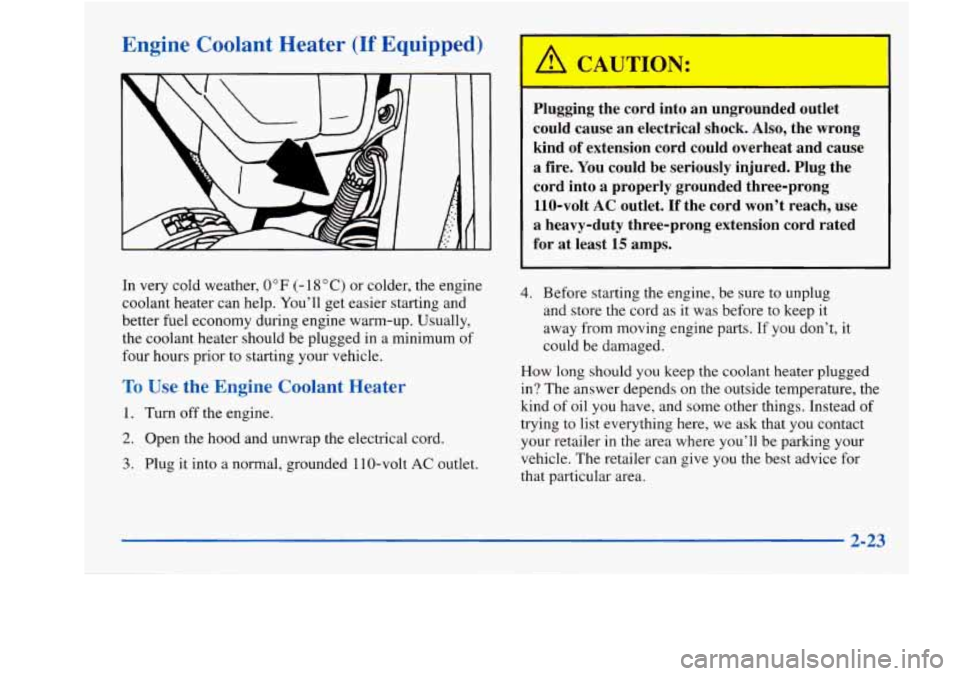
Engine Coolant Heater (If Equipped)
Plugging the cord into an ungrounded outlet
could cause an electrical shock. Also, the wrong
kind
of extension cord could overheat and cause
a fire. You could be seriously injured. Plug the
cord into
a properly grounded three-prong
110-volt
AC outlet. If the cord won’t reach, use
a heavy-duty three-prong extension cord rated
for
at least 15 amps.
In very cold weather,
0 OF (- 18 O C) or colder, the engine
coolant heater can help. You’ll get easier starting and
better fuel economy during engine warm-up. Usually,
the coolant heater should be plugged in a minimum of
four hours prior to starting your vehicle.
To Use the Engine Coolant Heater
1. Turn off the engine.
2. Open the hood and unwrap the electrical cord.
3. Plug it into a normal, grounded 1 10-volt AC outlet.
4. Before starting the engine, be sure to unplug
and store the cord as it was before to keep it
away from moving engine parts. If you don’t, it
could be damaged.
How long should you keep the coolant heater plugged
in? The answer depends on the outside temperature, the
kind of oil you have, and some other things. Instead
of
trying to list everything here, we ask that you contact
your retailer
in the area where you’ll be parking your
vehicle.
The retailer can give you the best advice for
that particular area.
2-23
Page 136 of 380
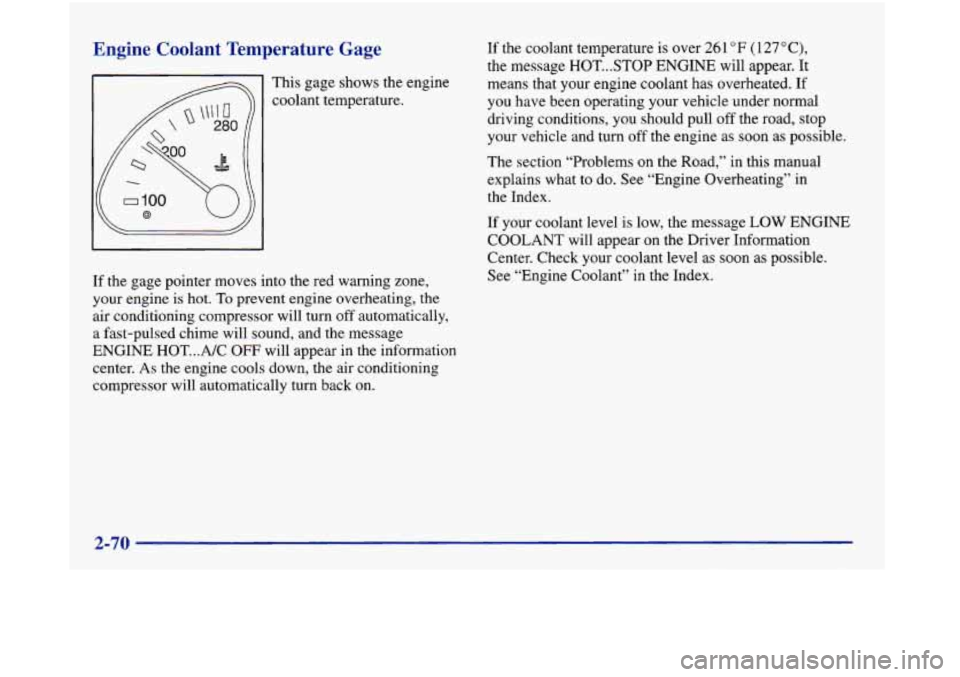
Engine Coolant Temperature Gage
This gage shows the engine
coolant temperature.
If the gage pointer moves into the red warning zone,
your engine is hot.
To prevent engine overheating, the
air conditioning compressor will turn
off automatically,
a fast-pulsed chime will sound, and the message
ENGINE
HOT ... A/C OW will appear in the information
center.
As the engine cools down, the air conditioning
compressor will automatically turn back on. If
the coolant temperature is over
261 OF (127 “C),
the message HOT. ..STOP ENGINE will appear. It
means that your engine coolant has overheated. If
you have been operating your vehicle under normal
driving conditions, you should pull off the road, stop
your vehicle and turn
off the engine as soon as possible.
The section “Problems on the Road,”
in this manual
explains what to
do. See “Engine Overheating” in
the Index.
If your coolant level
is low, the message LOW ENGINE
COOLANT will appear on the Driver Information
Center. Check your coolant level
as soon as possible.
See “Engine Coolant” in the Index.
2-70
Page 154 of 380
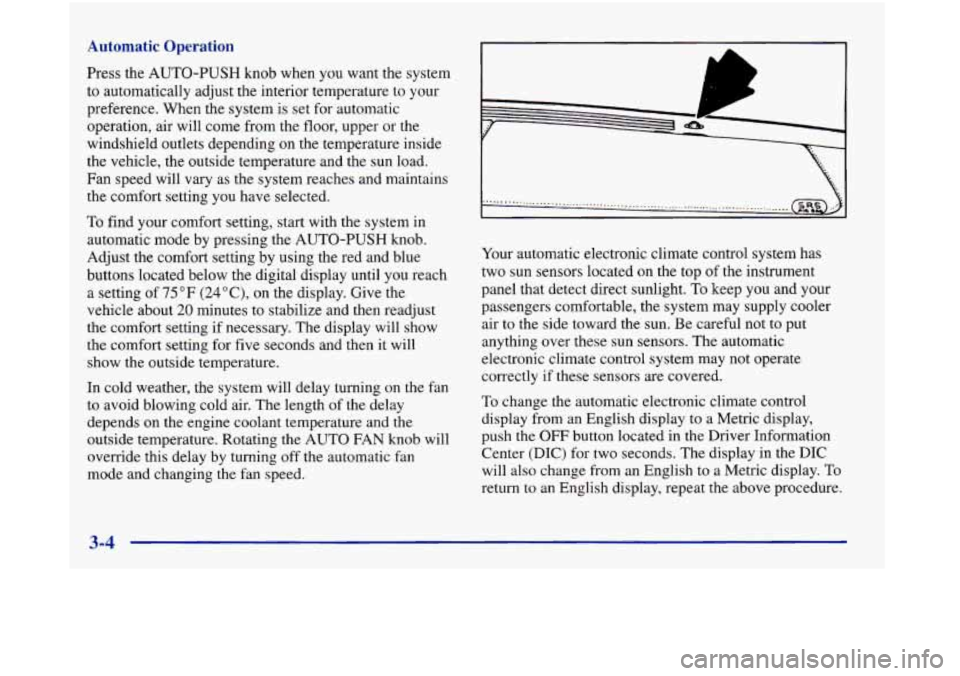
Automatic Operation
Press the AUTO-PUSH knob when you want the system
to automatically adjust the interior temperature to your
preference. When the system
is set for automatic
operation, air will come from the floor, upper or the
windshield outlets depending on the temperature inside
the vehicle, the outside temperature and the
sun load.
Fan speed will vary as the system reaches and maintains
the comfort setting you have selected.
To find your comfort setting, start with the system in
automatic mode by pressing the AUTO-PUSH knob.
Adjust the comfort setting by using the red and blue
buttons located below the digital display until
you reach
a setting of
75°F (24"C), on the display. Give the
vehicle about 20 minutes to stabilize and then readjust
the comfort setting
if necessary. The display will show
the comfort setting for five seconds and then it will
show the outside temperature.
In cold weather, the system will delay turning on the fan
to avoid blowing cold air. The length of the delay
depends
on the engine coolant temperature and the
outside temperature. Rotating the AUTO
FAN knob will
override this delay by turning off the automatic fan
mode and changing the fan speed.
...................................... ...................................................
Your automatic electronic climate control system has
two sun sensors located on the top of the instrument
panel that detect direct sunlight.
To keep you and your
passengers comfortable, the system may supply cooler
air to the side toward the sun. Be careful not to put
anything over these sun sensors. The automatic
electronic climate control system may not operate
correctly
if these sensors are covered.
To change the automatic electronic climate control
display from an English display to a Metric display,
push the
OFF button located in the Driver Information
Center (DIC) for two seconds. The display in the DIC
will also change from an English to a Metric display. To
return to an English display, repeat the above procedure.
Page 157 of 380
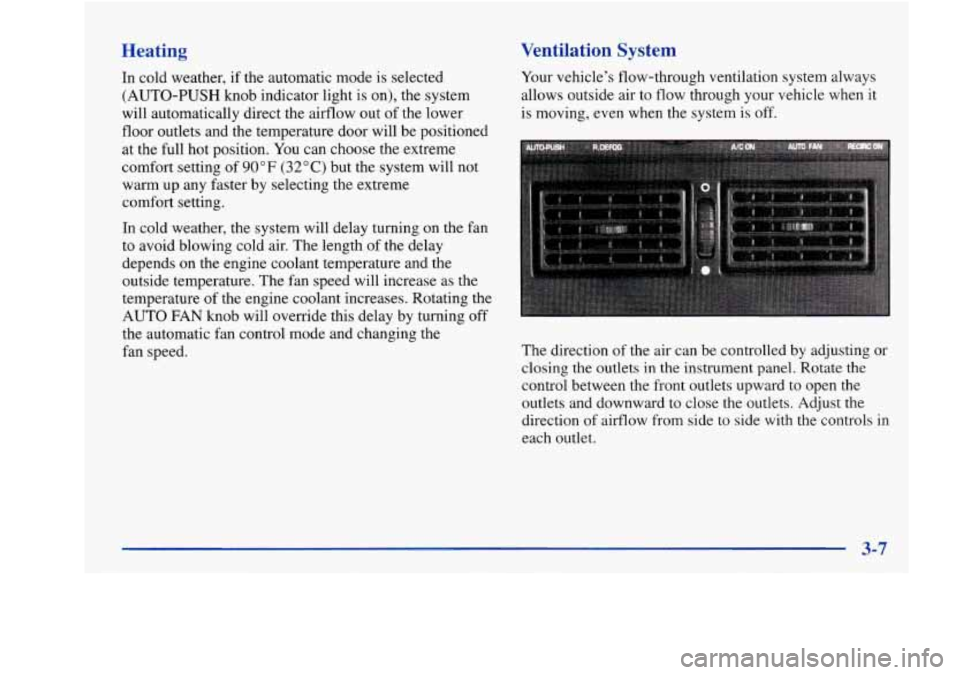
Heating
In cold weather, if the automatic mode is selected
(AUTO-PUSH knob indicator light is on), the system
will automatically direct the airflow out of the lower
floor outlets and the temperature door will be positioned
at the full hot position. You can choose the extreme
comfort setting of
90°F (32°C) but the system will not
warm
up any faster by selecting the extreme
comfort setting.
In cold weather, the system will delay turning on the fan
to avoid blowing cold air. The length of the delay
depends on the engine coolant temperature and the
outside temperature. The fan speed will increase as the
temperature
of the engine coolant increases. Rotating the
AUTO FAN
knob will override this delay by turning off
the automatic fan control mode and changing the
fan speed.
Ventilation System
Your vehicle’s flow-through ventilation system always
allows outside air
to flow through your vehicle when it
is moving, even when the system is off.
The direction of the air can be controlled by adjusting or
closing the outlets
in the instrument panel. Rotate the
control between the front outlets upward to open the
outlets and downward to close the outlets. Adjust the
direction of airflow
from side to side with the controls in
each outlet.
Page 230 of 380
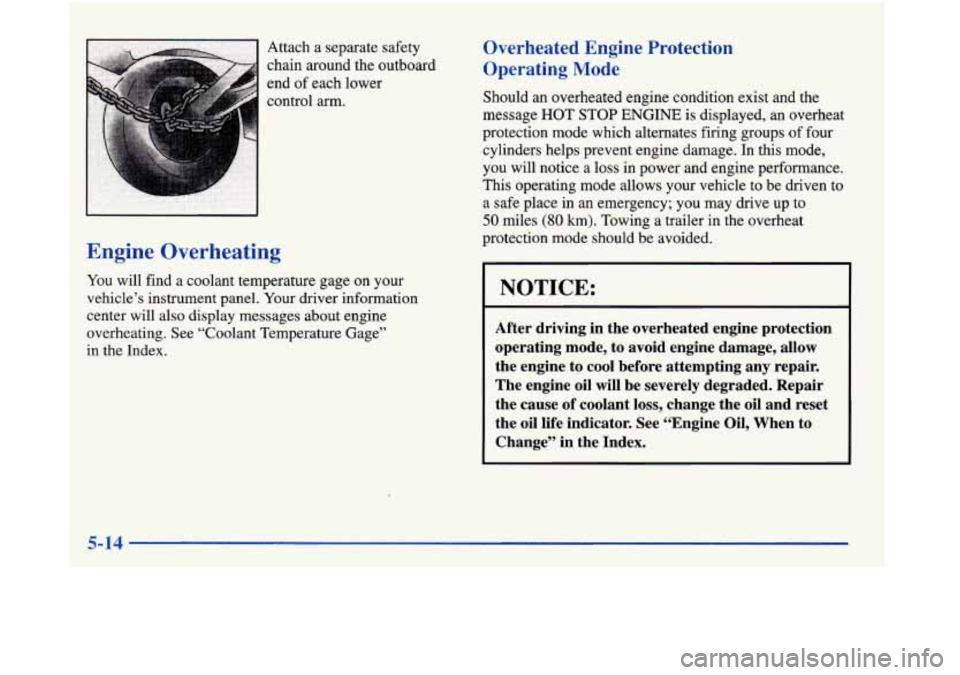
Engine Overheating
Attach a separate safety
chain around the outboard
end of each lower
control
arm.
You will find a coolant temperature gage on your
vehicle’s instrument panel. Your driver information
center will also display messages about engine
overheating. See “Coolant Temperature Gage”
in the Index.
Overheated Engine Protection
Operating Mode
Should an overheated engine condition exist and the
message HOT
STOP ENGINE is displayed, an overheat
protection mode which alternates firing groups of four
cylinders helps prevent engine damage. In this mode,
you will notice a loss in power and engine performance.
This operating mode allows your vehicle to be driven to
a safe place in an emergency; you may drive up to
50 miles (80 km). Towing a trailer in the overheat
protection mode should be avoided.
NOTICE:
After driving in the overheated engine protection
operating mode, to avoid engine damage, allow
the engine to cool before attempting any repair.
The engine oil will be severely degraded. Repair
the cause
of coolant loss, change the oil and reset
the oil life indicator. See “Engine Oil, When to
Change” in the Index.
5-14
Page 273 of 380
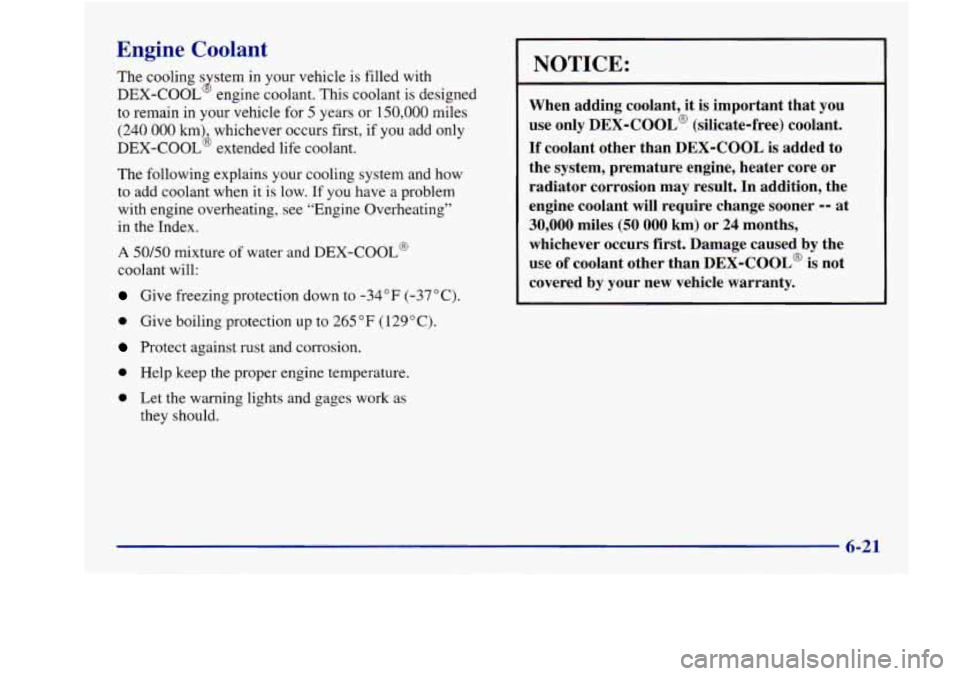
Engine Coolant
The cooling s stem in your vehicle is filled with
DEX-COOL engine coolant. This coolant is designed
to remain in your vehicle for
5 years or 150,000 miles
(240 000 km) whichever occurs first, if you add only
DEX-COOL’ extended life coolant.
J
The following explains your cooling system and how
to add coolant when it is low. If you have a problem
with engine overheating, see “Engine Overheating”
in the Index.
A 50/50 mixture of water and DEX-COOL@
coolant will:
Give freezing protection down to -34°F (-37°C).
0 Give boiling protection up to 265 “F (129 “C).
Protect against rust and corrosion.
0 Help keep the proper engine temperature.
0 Let the warning lights and gages work as
they should.
NOTICE:
When adding coolant, it is important that you
use only
DEX-COOL@ (silicate-free) coolant.
If coolant other than DEX-COOL is added to
the system, premature engine, heater core or
radiator corrosion may result. In addition, the
engine coolant will require change sooner
-- at
30,000 miles (50 000 km) or 24 months,
whichever occurs
first. Damage caused by the
use
of coolant other than DEX-COOL@ is not
covered by your new vehicle warranty.
Page 277 of 380
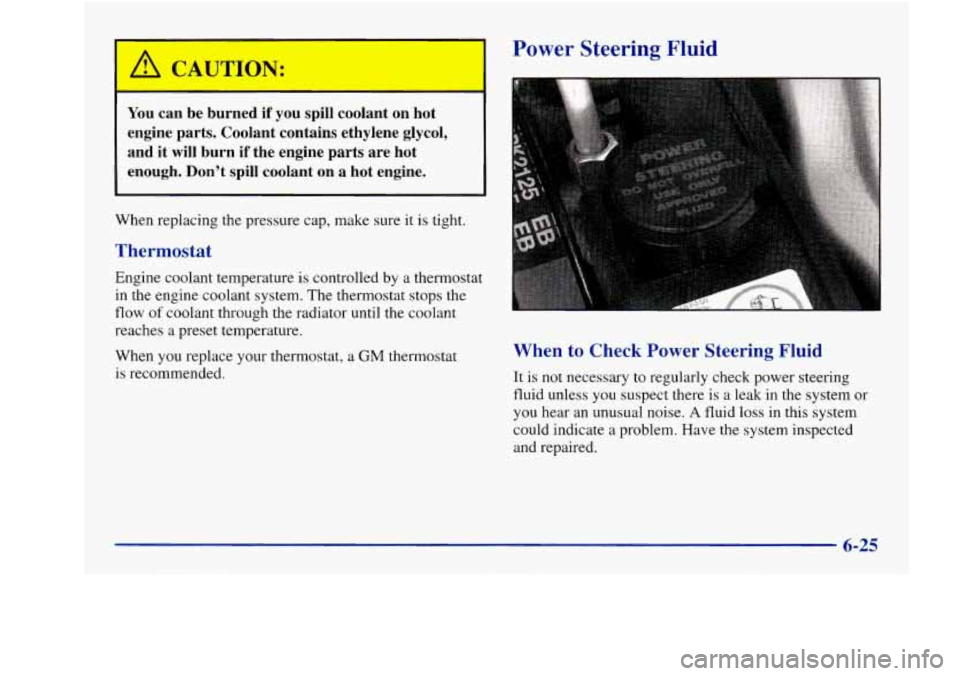
A CAUTION:
You can be burned if you spill coolant on hot
engine parts. Coolant contains ethylene glycol,
and it
will burn if the engine parts are hot
enough. Don’t spill coolant on a hot engine.
11
Power Steering Fluid
I I I
When replacing the pressure cap, make sure it is tight.
Thermostat
Engine coolant temperature is controlled by a thermostat
in the engine coolant system. The thermostat stops the
flow
of coolant through the radiator until the coolant
reaches a preset temperature.
When you replace your thermostat, a GM thermostat
is recommended.
When to Check Power Steering Fluid
It is not necessary to regularly check power steering
fluid unless you suspect there is a leak
in the system or
you hear an unusual noise.
A fluid loss in this system
could indicate a problem. Have the system inspected
and repaired.
6-25
Page 339 of 380
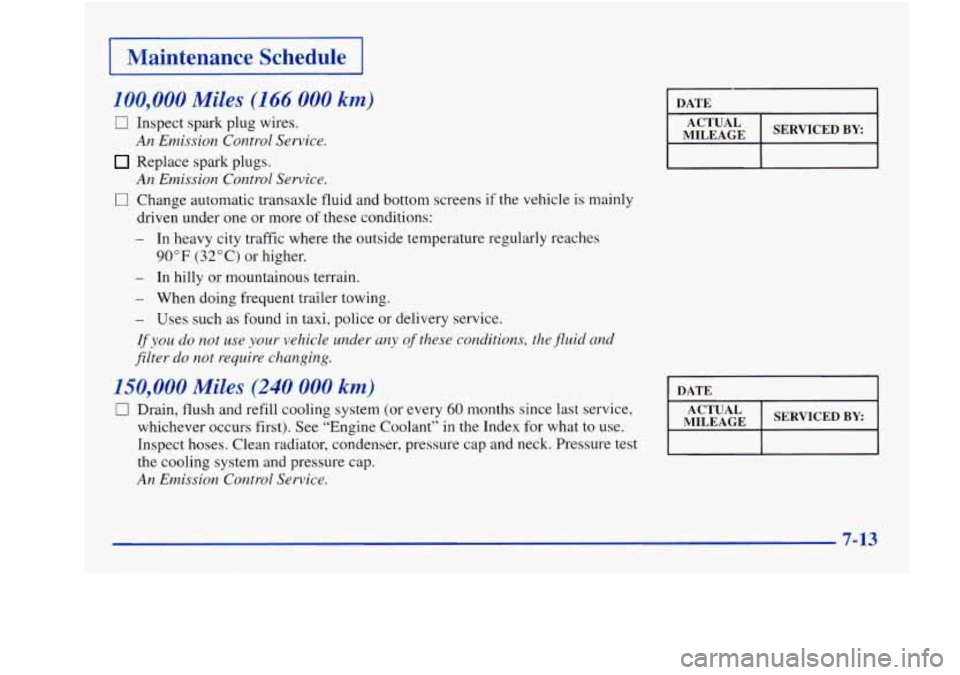
I Maintenance Schedule I
100,000 Miles (166 000 km)
0 Inspect spark plug wires.
Replace spark plugs.
0 Change automatic transaxle fluid and bottom screens if the vehicle is mainly
An Emission Control Service.
An Emission Control Service.
driven under one or more of these conditions:
I DATE 1
I MILEAGE ACTUAL I SERVICEDBY I
- In heavy city traffic where the outside temperature regularly reaches
90°F (32°C) or higher.
- In hilly or mountainous terrain.
- When doing frequent trailer towing.
- Uses such as found in taxi, police or delivery service.
If you do not use your veh.icle under any of these conditions, th.e jluid and
filter do not require changing.
150,000 Miles (240 000 km)
17 Drain, flush and refill cooling system (or every 60 months since last service,
MILEAGE whichever occurs first). See “Engine Coolant” in the Index for what to use.
Inspect hoses. Clean radiator, condenser, pressure cap and neck. Pressure test
the cooling system and pressure cap.
An Emission Control Service.
7-13
Page 366 of 380
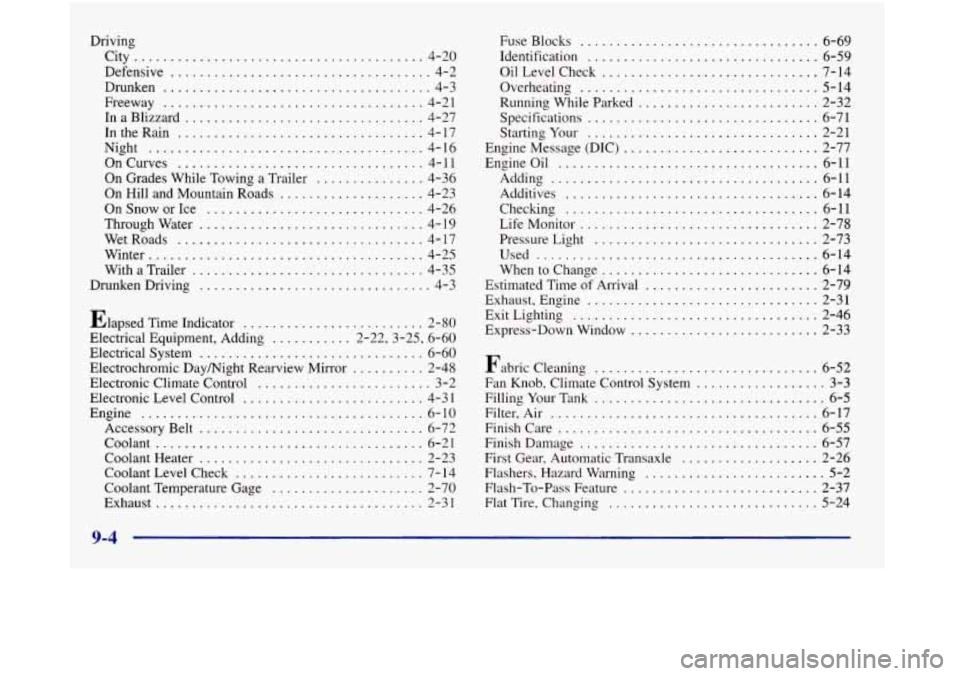
Driving City
........................................ 4-20
Defensive
.................................... 4-2
Drunken
..................................... 4-3
Freeway
.................................... 4-21
InaBlizzard
................................. 4-27
IntheRain
.................................. 4-17
OnCurves
.................................. 4-11
On Grades While Towing a Trailer
............... 4-36
On Hill and Mountain Roads
.................... 4-23
On Snow
or Ice .............................. 4-26
Throughwater
............................... 4-19
WetRoads .................................. 4-17
Winter
...................................... 4-25
With a Trailer
................................ 4-35
DrunkenDriving
................................ 4-3
Night
...................................... 4-16
Elapsed Time Indicator
......................... 2-80
Electrical Equipment. Adding ........... 2.22. 3.25. 6-60
Electrical System
............................... 6-60
Electrochromic Daymight Rearview Mirror
.......... 2-48
Electronic Climate Control
........................ 3-2
Electronic Level Control
......................... 4-3 1
Engine ....................................... 6-10
Accessory Belt
............................... 6-72
Coolant
..................................... 6-21
Coolant Heater
............................... 2-23
Coolant Level Check
.......................... 7- 14
Coolant Temperature Gage
..................... 2-70
Exhaust
..................................... 2-31 Fuse Blocks
................................. 6-69
Identification
................................ 6-59
OilLevelCheck .............................. 7-14
Overheating
................................. 5-14
Running While Parked
......................... 2-32
Specifications
................................ 6-71
Starting Your
................................ 2-21
Engine Message (DIC)
........................... 2-77
EngineOil
.................................... 6-11
Adding
..................................... 6-11
Additives
................................... 6-14
Checlung
................................... 6-11
Life Monitor ................................. 2-78
Pressure Light
............................... 2-73
Used
....................................... 6-14
Whentochange
.............................. 6-14
Estimated Time
of Arrival ........................ 2-79
Exhaust, Engine
................................ 2-31
Exit Lighting
.................................. 2-46
Express-Down Window
.......................... 2-33
Fabric Cleaning
............................... 6-52
Fan Knob. Climate Control System
.................. 3-3
Filling Your Tank ................................ 6-5
Filter. Air
..................................... 6-17
Finish Care
.................................... 6-55
Finish Damage
................................. 6-57
First Gear. Automatic Transaxle
................... 2-26
Flashers. Hazard Warning
......................... 5-2
Flash-To-Pass Feature ........................... 2-37
Flat Tire. Changing
............................. 5-24
9-4
Page 367 of 380
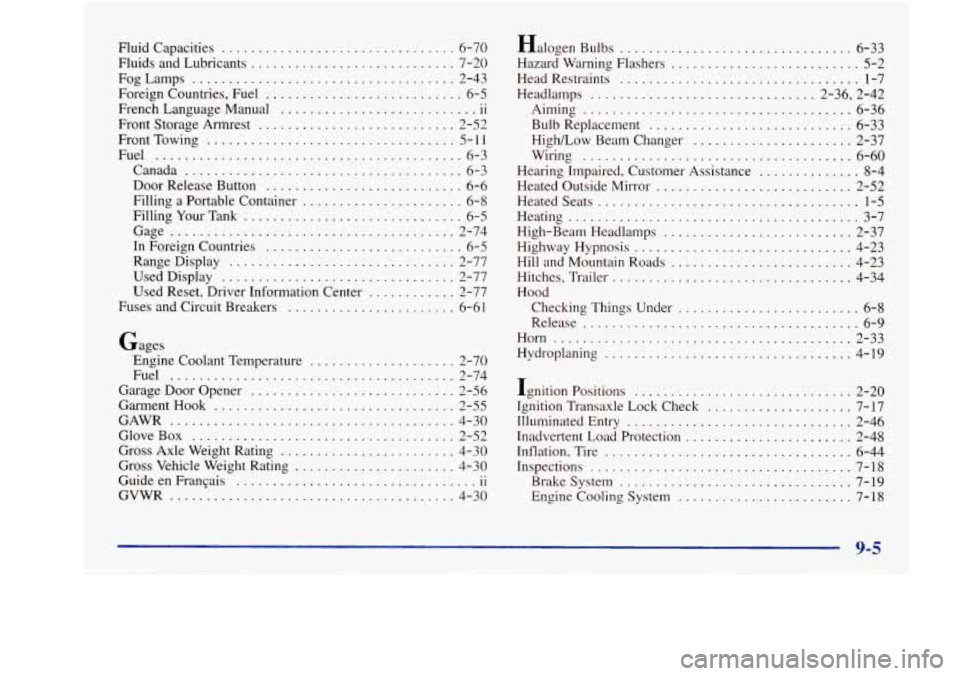
Fluid Capacities ................................ 6-70
FogLamps
.................................... 2-43
Foreign Countries. Fuel
........................... 6-5
Front Storage Armrest
........................... 2-52
Fluids and Lubricants
............................ 7-20
FrenchLanguage Manual
11
FrontTowing .................................. 5-11
Fuel
.......................................... 6-3
Canada
...................................... 6-3
Door Release Button
........................... 6-6
Filling a Portable Container
...................... 6-8
Filling Your Tank
.............................. 6-5
Gage
....................................... 2-74
In Foreign Countries
........................... 6-5
RangeDisplay
............................... 2-77
UsedDisplay
................................ 2-77
Used Reset. Driver Information Center
............ 2-77
Fuses and Circuit Breakers
....................... 6-61
.. ...........................
Gages
Engine Coolant Temperature
.................... 2-70
Fuel
....................................... 2-74
Garage Door Opener
............................ 2-56
GarmentHook
................................. 2-55
GloveBox
.................................... 2-52
Gross Axle Weight Rating
........................ 4-30
Gross Vehicle Weight Rating
...................... 4-30
Guide en Frangais
11
GAWR ....................................... 4-30
.. .................................
GVWR ....................................... 4-30 Halogen
Bulbs
................................ 6-33
Hazard Warning Flashers
.......................... 5-2
Head Restraints
................................. 1-7
Headlamps
............................... 2-36, 2-42
Aiming
..................................... 6-36
Bulb Replacement
............................ 6-33
Wiring
..................................... 6-60
High/Low Beam Changer ...................... 2-37
Hearing Impaired. Customer Assistance
.............. 8-4
Heated Outside Mirror
........................... 2-52
Heatedseats
.................................... 1-5
Heating ........................................ 3-7
High-Beam Headlamps
.......................... 2-37
Highway Hypnosis
.............................. 4-23
Hill and Mountain Roads
......................... 4-23
Hitches. Trailer
................................. 4-34
Hood Checking Things Under
......................... 6-8
Release
...................................... 6-9
Horn
......................................... 2-33
Hydroplaning
.................................. 4-19
Ignition Positions
.............................. 2-20
Ignition Transaxle Lock Check
.................... 7-17
Illuminated Entry
............................... 2-46
Inadvertent Load Protection
....................... 2-48
Inflation. Tire
.................................. 6-44
Inspections
.................................... 7-18
Brakesystem
................................ 7-19
Engine Cooling System ........................ 7-18